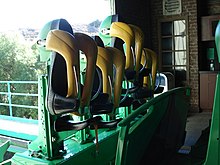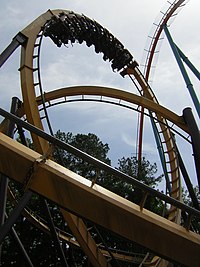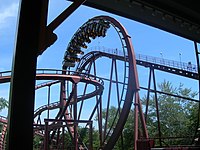| Stand-up roller coaster | |
|---|---|
 The Riddler's Revenge, a stand-up coaster that features a vertical loop which wraps around the lift hill. The Riddler's Revenge, a stand-up coaster that features a vertical loop which wraps around the lift hill. | |
| Status | In production |
| First manufactured | 1984 |
| No. of installations | 22 (9 in operation) |
| Manufacturers | TOGO Arrow Dynamics Bolliger & Mabillard Intamin |
| First retrofit | 1982 |
A stand-up roller coaster is a roller coaster where passengers aboard a train stand throughout the course of the ride. The first manufacturer to employ the format was TOGO, a Japanese company that converted two traditional roller coasters in 1982 to stand-up configurations. Arrow Dynamics followed suit in the United States the following year with their own conversion. The first roller coaster designed from the ground up as a stand-up coaster was King Cobra, built by TOGO, which opened at Kings Island in 1984. Intamin and Bolliger & Mabillard (B&M) have also designed stand-up models beginning in the 1990s, with the latest opening in 2023 as Pipeline: The Surf Coaster in SeaWorld Orlando, which was the first stand up roller coaster built since 1999's Georgia Scorcher at Six Flags Over Georgia.
Although riders stand, they have access to a height-adjustable bicycle seat in many configurations. Older designs from the now-defunct TOGO typically used over-the-shoulder or lap-bar restraints to secure riders. B&M models add a seat belt that connects the bicycle seat to the harness for additional security.
History
The first stand-up roller coasters in the world were originally built as sit-down roller coasters. Japanese manufacturer TOGO designed stand-up roller coasters that were first deployed in 1982 on Momonga Standing & Loop Coaster, originally built in 1979 at Yomiuriland in Tokyo, Japan. The same change was also performed on Dangai at the former Thrill Valley amusement park in Gotemba, Shizuoka, Japan. Both rides added stand-up trains in 1982, with Dangai opening one day before Momonga Standing & Loop Coaster.
The first stand-up roller coaster in the United States was also a former sit-down model. Screamroller at Worlds of Fun was a common corkscrew layout found at multiple parks and was built by Arrow Dynamics in 1976. In 1983, Arrow designed its own stand-up train for the attraction, and the ride was subsequently renamed ExtremeRoller after the trains were added. The original sit-down trains were reinstalled several years later. Arrow retrofitted another coaster in 1984 called River King Mine Train, which originally debuted at the grand opening of Six Flags St. Louis in 1971. Arrow added stand-up trains for the 1984 season, and the attraction was renamed Rail Blazer. The track wasn't intended for use with stand-up trains, and a fatal accident in 1984 – involving a passenger that was ejected from her seat – prompted a recall of the trains. The original trains and name of the ride were restored in 1985.
TOGO set out to design the first ever stand-up roller coaster from the ground up and successfully tested a prototype in the parking lot of their Tokyo plant. Named Astro-Comet, the prototype was purchased by Kings Island, an amusement park in the US looking for the proper ride to celebrate the 100th anniversary of America's first roller coaster. It opened at Kings Island in 1984 as King Cobra and operated until 2001.
In 1986, Intamin built their first stand up coaster, Shockwave at Six Flags Magic Mountain (later renamed Batman: The Escape and relocated to the now-defunct Six Flags Astroworld), which used four across seating and their new box spine track, and featured Intamin's first vertical loop. In 2005, it was disassembled and placed in storage at Six Flags Darien Lake, where it sat until its eventual removal in 2017.
The most recent stand-up roller coaster to be manufactured (the first since 1999's Georgia Scorcher at Six Flags Over Georgia) was SeaWorld Orlando's surfing-themed Pipeline: The Surf Coaster, which opened on May 27, 2023. In addition to surfboard-designed cars, Pipeline features modernized and comfortable vest restraints and bicycle-style seats which move several inches up and down, to simulate the feelings of actually surfing. Unlike the older style, it also features two across seating and a launch.
Design

Three manufacturers—TOGO, Intamin and Bolliger & Mabillard—have constructed multiple stand-up roller coasters. TOGO's stand-up models feature cars that seat four passengers in two rows of two. Models from Intamin and B&M also seat four riders per car, but in a single four-abreast row.
On a standard roller coaster, the rider is held in their seat by some form of harness, such as a lap bar or an over-the-shoulder restraint. As stand-up roller coasters, by their design, do not have "seats," the harness system must both restrain and support the rider. Typical stand-up roller coaster harnesses are mounted on vertical posts, which allow the harness to adjust to riders of different heights. At the bottom is a seat resembling that on a bicycle, while at the top is an over-the-shoulder harness. TOGO models normally use a lap bar to further secure riders, while B&M models add a seat belt to connect the bicycle seat to the shoulder harness.
With some exceptions, stand-up roller coasters normally feature at least one inversion. These inversions can include vertical loops, inclined loops, dive loops and corkscrews. Only one stand-up roller coaster, the Shockwave at Drayton Manor Theme Park in the United Kingdom, includes a zero-gravity roll.
Installations



Modified stand-up roller coasters
| Name | Park | Manufacturer | Opened | Closed | Details |
|---|---|---|---|---|---|
| Momonga Standing and Loop Coaster | Yomiuriland | TOGO | 1979 | 2021 | Stand-up trains added in 1982 |
| Dangai | Thrill Valley | TOGO | 1982 | 2002 | Stand-up trains added in 1982 |
| Extremeroller | Worlds of Fun | Arrow Dynamics | 1976 | 1988 | Stand-up trains in added 1983, removed several years later |
| Rail Blazer | Six Flags St. Louis | Arrow Dynamics | 1971 | — | Stand-up trains added in 1984, removed in 1985 |
| Pink Typhoon Standing Coaster (formerly Star Jet) |
Washuzan Highland | TOGO | 1986 | — | Stand-up train added on or before 1998 |
Purpose-built stand-up roller coasters
References
- Marden, Duane. "Momonga Standing & Loop Coaster (Yomiuri land)". Roller Coaster DataBase.
- ^ Marden, Duane. "Dangai (Thrill Valley)". Roller Coaster DataBase.
- ^ Marden, Duane. "Extremeroller (Worlds of Fun)". Roller Coaster DataBase. Retrieved November 20, 2023.
- ^ Marden, Duane. "River King Mine Train (Six Flags St. Louis)". Roller Coaster DataBase. Retrieved October 14, 2009.
- "July 7, 1984: Woman killed in fall from Six Flags ride". 7 July 2020.
- Kruthoffer, Kyle (August 22, 2020). "The Astro-Comet: Remembering King Cobra". Kings Island. Archived from the original on September 20, 2022. Retrieved September 20, 2022.
- Marden, Duane. "Unknown (Six Flags Darien Lake)". Roller Coaster DataBase. Retrieved 2009-10-14.
- Carter, Ashley (11 May 2023). "SeaWorld Orlando Ready to Make Waves With Pipeline Coaster". MyNews13.com. Retrieved 12 May 2023.
External links
| Types of roller coaster | |
|---|---|
| Construction material | |
| Train configuration | |
| Track layout | |
| Bolliger & Mabillard | |
|---|---|
| List of roller coasters | |
| Current Models | |
| Notable coasters | |
| Website: www | |
| Intamin | |
|---|---|
| List of Intamin rides | |
| Current roller coaster models | |
| Discontinued roller coaster models |
|
| Other current rides | |
| Other discontinued rides | |
| Notable rides |
|